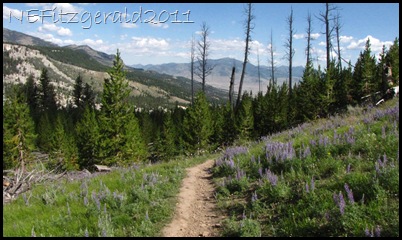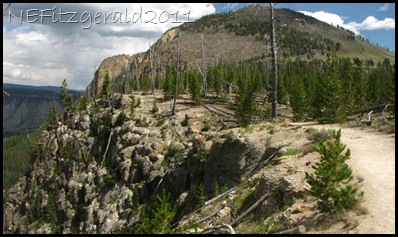What a difference twelve months makes! This time last year I was working at Katmai National Park and Preserve in Alaska, robotically lobbing pumice into Naknek Lake on my days off and wondering if I’d ever get to Novarupta. This summer I find myself in Yellowstone, and every weekend I discover some different area of the park to explore and some new trail to hike. Perhaps one major difference is that I have my car in Yellowstone, and there are over one thousand miles of trails just waiting for me to take advantage of the next “feet photo” opportunity. Trails were few and far between in Katmai.
 |
| Feet with a view |
My latest pick–of–the–week was Bunsen Peak, in the northwest section of the park just outside of Mammoth Hot Springs. Although Bunsen Peak is only 70 miles from Grant Village, the drive took an hour and a half due to the twisting, narrow park road and 45–mile–per–hour speed limit. A few miles south of the trailhead we spotted a grizzly bear crossing the road. There was little traffic at that early morning hour, just three or four cars including mine, but the grizzly appeared stressed as it zigged and zagged its way past us and disappeared down an embankment. Lucky for the frazzled grizzly there was scant time for the usual circus of wildlife–watching vehicles and their occupants to accumulate along the side of the road.
Bunsen Peak rises to 8,564 feet above sea level, a remnant intrusive plug of dacitic igneous intrusion which formed during the Absaroka volcanic event of around 50 million years ago during the Eocene epoch. The eruption of Bunsen Peak is also related in time and volcanism to the activity of Mt. Washburn. According to “Yellowstone Place Names,” its name came about in 1872 during the second Hayden expedition. It was named for Robert Wilhelm Eberhard von Bunsen (indeed!) who was a chemist, the inventor of the spectroscope and the Bunsen electric cell, and (appropriately for geology) the discoverer of the elements cesium and rubidium, which have really long half–lives and so can be used to date really old rocks. Interestingly, “Yellowstone Place Names” states that the Bunsen burner was named for him but he was probably not the inventor. I will leave it to the astute WATCH FOR ROCKS reader to confirm or deny this allegation.
 |
| Lupines along the trail |
 |
| Swan Lake and Gardners Hole; Gallatin Range in distance |
The ascent to the summit is around 1,300 feet over 2.1 miles, so we were steady up and up. Along the way we stopped to look at nearly every rock, wildflower, and viewpoint. At this blistering pace, Jan and I burned our way to the top in a record two hours. I know one mile an hour might seem a bit slow for some of you, but hey! We had the time and we have the aging knees to amble at our leisure. We definitely were not interested in breaking any land–speed records while ascending 650 feet per mile. We had nowhere to go but up.
 |
| Trail to Bunsen Peak |
But what the heck are these rocks?

And what’s this windowless structure doing on top of the mountain?







